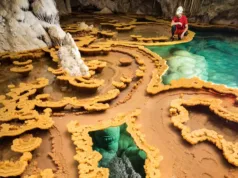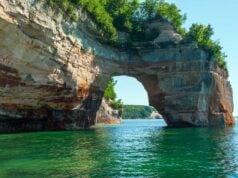The Blue Lagoon is a geothermal spa located in southwestern Iceland, approximately 50 kilometers (31 miles) from the capital city, Reykjavik. It is one of Iceland’s most famous attractions and is renowned for its vivid blue-colored, mineral-rich waters. While the Blue Lagoon may appear to be a natural phenomenon, it is actually a man-made geothermal pool created by a nearby geothermal power plant.
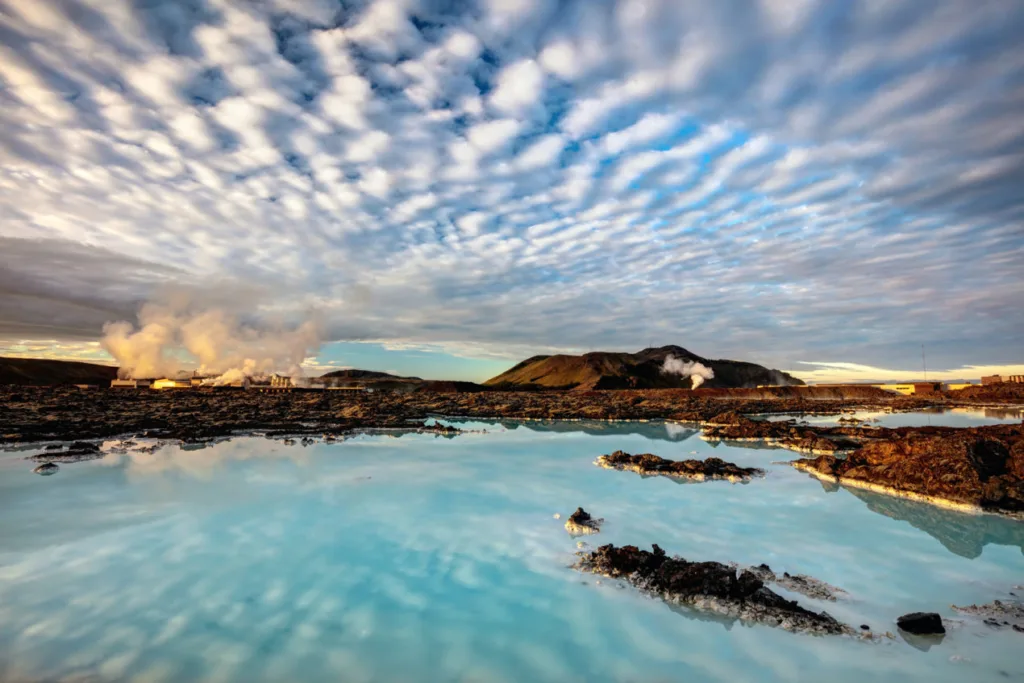

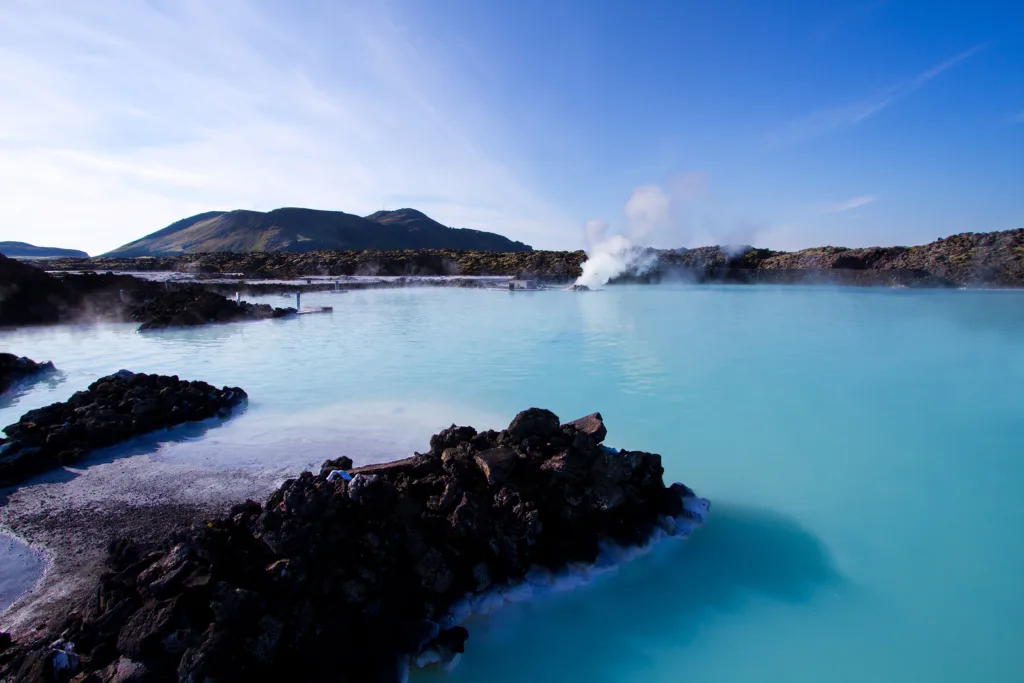
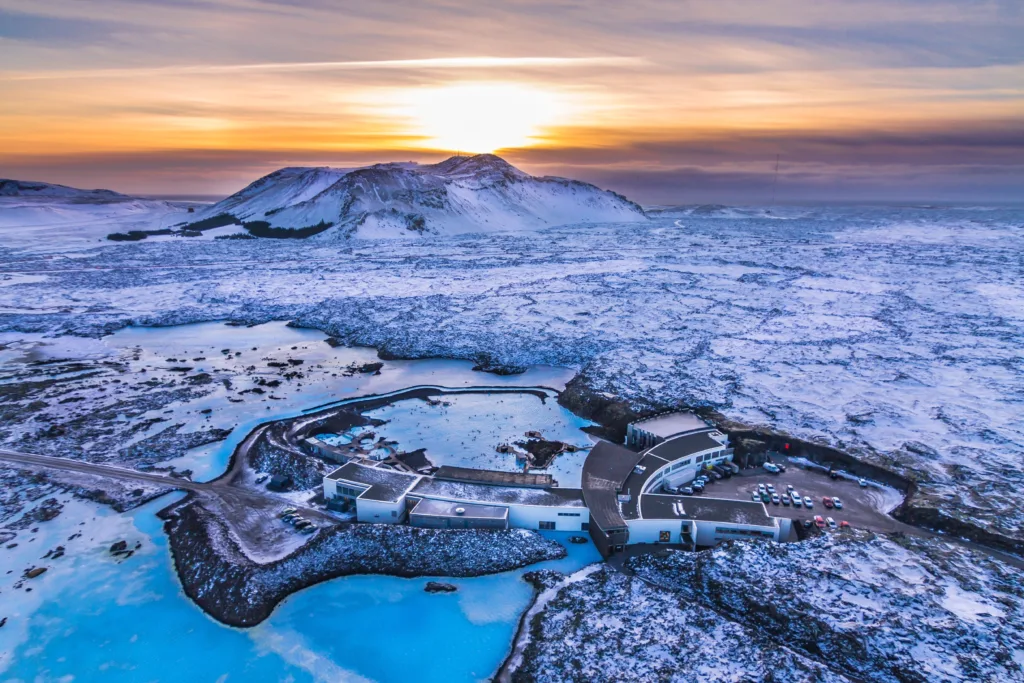
The geology of the Blue Lagoon area is closely tied to Iceland’s unique geological features. Iceland sits atop the Mid-Atlantic Ridge, a tectonic boundary where the Eurasian and North American plates meet. This positioning makes Iceland a geologically active region with a high concentration of geothermal activity, including volcanic eruptions, geysers, and hot springs.
The Blue Lagoon is situated within a lava field formed by a volcanic eruption that occurred around 800 years ago. The lava field, known as the Svartsengi (Black Meadow), covers a significant area and is composed of dark basaltic rocks. Beneath the lava field lies a reservoir of geothermal seawater, heated by the Earth’s internal heat.
The geothermal power plant, Svartsengi Geothermal Power Station, taps into this reservoir to generate electricity and hot water for heating purposes. As a byproduct of the power plant’s operations, the excess geothermal seawater is discharged into the Blue Lagoon, creating a warm and mineral-rich bathing environment.
The unique blue color of the lagoon’s water is a result of the interaction between the silica-rich geothermal water and the sunlight. The water’s composition, which includes minerals like silica, algae, and other microorganisms, gives it its distinct milky blue appearance.
In addition to its aesthetic appeal, the Blue Lagoon is believed to have therapeutic qualities due to its mineral content. Visitors often indulge in bathing, mud masks, and other spa treatments that utilize the lagoon’s waters, which are said to have healing properties for various skin conditions such as psoriasis and eczema.
Over the years, the Blue Lagoon has become a popular tourist destination and a symbol of Iceland’s geothermal wonders. It showcases the country’s geological uniqueness and offers visitors a chance to immerse themselves in a one-of-a-kind natural spa experience.
Formation of the Blue Lagoon
The formation of the Blue Lagoon can be attributed to the Svartsengi Geothermal Power Station and its activities in harnessing geothermal energy. Here is an overview of the formation process:
- Geothermal Seawater Source: The Blue Lagoon’s water originates from a reservoir of geothermal seawater that lies beneath the Svartsengi lava field. This seawater is a mixture of groundwater and seawater that has been heated by the Earth’s geothermal heat.
- Geothermal Power Plant Operations: The Svartsengi Geothermal Power Station, located near the Blue Lagoon, harnesses the geothermal energy by extracting the superheated water from the underground reservoir. The water is used to drive turbines, generating electricity and producing hot water for heating purposes in nearby communities.
- Water Discharge: As a result of the power plant’s operations, excess geothermal seawater is discharged from the power plant into the surrounding area. Initially, this water was released into the nearby lava field.
- Water and Lava Interaction: When the superheated geothermal seawater comes into contact with the cold lava field, a series of chemical reactions occur. The water dissolves minerals, primarily silica, from the surrounding volcanic rock, creating a unique mineral-rich composition.
- Formation of the Blue Lagoon: Over time, the discharge of the geothermal seawater into the lava field formed a man-made pool, which eventually became known as the Blue Lagoon. The pool gradually expanded and took on its characteristic vivid blue color due to the interaction between the silica-rich water and sunlight.
- Human Intervention: To enhance the Blue Lagoon as a bathing and spa facility, human interventions were made. The pool’s bottom was paved, and facilities such as changing rooms, walkways, and spa amenities were added to accommodate visitors.
It’s important to note that the Blue Lagoon is not a naturally occurring geothermal pool but rather a result of the interaction between the geothermal power plant’s operations, the discharge of heated seawater, and the surrounding geological environment. However, despite its artificial origin, the Blue Lagoon has become a natural marvel and an iconic destination in Iceland.
Hydrothermal Systems
Hydrothermal systems are geological systems that involve the circulation of hot water or steam in the Earth’s crust. These systems are driven by heat generated from magma or the natural decay of radioactive elements in the Earth’s interior. Hydrothermal systems are found in various geologic settings, including volcanic regions, geothermal areas, and areas with active tectonic activity.
The key components of a hydrothermal system are:
- Heat Source: The heat required to drive a hydrothermal system comes from the Earth’s internal heat. This heat can originate from the molten magma beneath the Earth’s surface or from the natural radioactive decay of elements like uranium, thorium, and potassium.
- Water Reservoir: A hydrothermal system requires a reservoir of water. This water can come from various sources, including rainfall, surface water, or groundwater that has infiltrated into the subsurface. In some cases, the water may be seawater that has percolated through porous rocks.
- Permeable Pathway: The water needs a permeable pathway through which it can circulate. This pathway is typically provided by fractures, faults, or porous rocks that allow the water to move through the subsurface.
- Circulation: As the hot water or steam is heated by the heat source, it becomes buoyant and rises towards the surface. This circulation is driven by convection, where the hot fluids rise and the cooler fluids sink. The circulating fluids carry heat and dissolved minerals from the depths of the system.
- Alteration and Mineralization: As the hot water or steam circulates through the hydrothermal system, it can interact with the surrounding rocks, causing alteration and mineralization. The hot fluids can react with the minerals in the rocks, leading to the formation of new minerals and the alteration of the original rock composition. This process can result in the deposition of valuable minerals, such as gold, silver, copper, and other metallic ores.
Hydrothermal systems can manifest in various forms, including geysers, hot springs, fumaroles (openings that emit steam and gases), and hydrothermal vents on the ocean floor. These systems play a crucial role in Earth’s geologic processes, influencing the formation of mineral deposits, shaping volcanic activity, and providing unique habitats for specialized organisms.
In addition, hydrothermal systems have practical significance. Geothermal energy, for example, is harnessed from hydrothermal systems to generate electricity and provide heating and cooling for residential and industrial use. The hot water and steam from these systems can also be utilized in spas and wellness resorts for therapeutic and recreational purposes.
Mineral Content and Chemistry of Blue Lagoon
The Blue Lagoon in Iceland is known for its mineral-rich waters, which contribute to its unique color and potential therapeutic properties. Here is an overview of the mineral content and chemistry of the Blue Lagoon:
- Silica (Silicon Dioxide): Silica is one of the key minerals found in the Blue Lagoon. It is responsible for the lagoon’s milky blue appearance. The silica-rich water reflects sunlight, creating the vibrant blue color. Silica also contributes to the water’s viscosity, giving it a smooth and gel-like texture.
- Algae and Minerals: The Blue Lagoon contains a variety of algae and other microorganisms. These organisms thrive in the warm, mineral-rich environment. Algae can contribute to the water’s bluish-green tint and can provide additional health benefits to the skin.
- Minerals and Trace Elements: The geothermal seawater of the Blue Lagoon contains a range of minerals and trace elements, including:
- Sodium: Sodium ions (Na+) are abundant in the water and contribute to its salinity.
- Calcium: Calcium ions (Ca2+) are present in the water and can contribute to the lagoon’s potential therapeutic effects on the skin.
- Magnesium: Magnesium ions (Mg2+) are present in significant amounts and are believed to have a soothing effect on the skin.
- Potassium: Potassium ions (K+) are found in the water and play a role in maintaining the body’s electrolyte balance.
- Sulfur: Sulfur compounds are present in the water and give off a distinct odor. Sulfur is known for its potential anti-inflammatory and antibacterial properties.
- Chloride: Chloride ions (Cl-) are present and contribute to the overall salinity of the water.
- Other trace elements: The water may contain trace amounts of elements like iron, zinc, manganese, and others, which can have various effects on the skin and overall well-being.
- pH and Alkalinity: The Blue Lagoon has a slightly alkaline pH, typically ranging from around 7.5 to 8.5. The alkaline nature of the water can help to balance the skin’s pH and provide a soothing effect.
It’s important to note that the mineral content of the Blue Lagoon can vary, and the precise concentrations may change over time. The specific composition of minerals and trace elements contributes to the unique properties of the Blue Lagoon’s waters and is believed to offer potential benefits for skin health and well-being.
Geothermal Activity in Iceland
Iceland is renowned for its abundant geothermal activity, which is a direct result of its location on the Mid-Atlantic Ridge—a tectonic boundary where the Eurasian and North American plates meet. Here are some key aspects of geothermal activity in Iceland:
- Volcanism: Iceland is a highly volcanic region, with numerous active volcanoes and volcanic systems. The island sits on a hot spot, where magma from the Earth’s mantle rises to the surface, leading to frequent volcanic eruptions. The volcanic activity provides the heat source for Iceland’s geothermal systems.
- Geothermal Power Generation: Iceland harnesses its geothermal resources for electricity generation and heating. Geothermal power plants tap into the superheated water and steam reservoirs beneath the Earth’s surface to drive turbines, producing electricity. The country has a significant reliance on geothermal energy, with a substantial portion of its electricity and heating needs met through geothermal power plants.
- Hot Springs: Iceland is dotted with numerous hot springs, which are geothermal features where hot water from underground reservoirs emerges at the surface. The hot springs vary in size and temperature, providing unique bathing experiences for locals and tourists alike. Some popular hot springs include the Blue Lagoon, Mývatn Nature Baths, and Landmannalaugar hot springs.
- Geothermal Areas: Iceland has several geothermal areas characterized by a concentration of geothermal features, such as geysers, fumaroles, and hot springs. The most famous geothermal area is the Haukadalur Geothermal Valley, home to the renowned Geysir and Strokkur geysers. These areas showcase the dynamic nature of geothermal activity, with geysers erupting and hot springs emitting steam and gases.
- Geothermal Heating: Geothermal energy is widely used for heating purposes in Iceland. Hot water from geothermal sources is distributed through a network of pipes to heat homes, buildings, and even sidewalks in urban areas. This geothermal heating system takes advantage of the natural warmth beneath the Earth’s surface and provides a sustainable and efficient heating solution for Icelandic communities.
- Geothermal Research and Innovation: Iceland’s abundant geothermal resources have made it a hub for geothermal research and innovation. The country hosts research institutions, geothermal conferences, and geothermal companies that develop new technologies and explore geothermal energy potential both domestically and globally.
The geothermal activity in Iceland is not only a valuable source of renewable energy but also a significant natural attraction, drawing visitors from around the world to experience the unique geothermal features, hot springs, and geothermal spas that showcase Iceland’s geologic wonders.
The history of the Blue Lagoon and its discovery
The history of the Blue Lagoon can be traced back to the 1970s when it was accidentally discovered as a byproduct of the nearby Svartsengi Geothermal Power Station. Here is an overview of the history and discovery of the Blue Lagoon:
- Formation of the Svartsengi Geothermal Power Station: In the early 1970s, the Svartsengi Geothermal Power Station was constructed near Grindavík, in southwestern Iceland. The power station was built to harness the geothermal energy from the underground reservoirs to generate electricity and provide heating for nearby communities.
- Discharge of Geothermal Seawater: As part of the power station’s operations, excess geothermal seawater, heated by the geothermal processes, was discharged into the surrounding lava field. Initially, the water was released into the rugged and barren landscape.
- Discovery by Locals: Local residents, curious about the warm and mineral-rich water, began bathing in the discharge site. They noticed that the water had potential therapeutic effects on various skin ailments, such as psoriasis and eczema. The warm and soothing water quickly gained popularity among the locals.
- Recognition of Health Benefits: The positive reports about the water’s health benefits spread, and the site gained recognition for its potential therapeutic properties. People from nearby towns and cities started visiting the site to experience the healing effects of the water.
- Development as a Spa: Recognizing the growing interest and potential for tourism, the site was further developed to accommodate visitors. Facilities such as changing rooms, showers, and walkways were added to enhance the visitor experience.
- Opening of the Blue Lagoon: In 1987, the Blue Lagoon officially opened as a public bathing and spa facility. It quickly gained popularity among both domestic and international visitors due to its unique geothermal properties, vibrant blue color, and purported health benefits.
- Ongoing Development and Expansion: Over the years, the Blue Lagoon has undergone continuous development and expansion to cater to the increasing number of visitors. Additional amenities and services, including a luxury hotel, restaurants, and spa treatments, have been introduced to provide a comprehensive wellness experience.
Today, the Blue Lagoon is one of Iceland’s most famous and iconic attractions, attracting hundreds of thousands of visitors each year. It is renowned for its mineral-rich waters, striking blue color, and the opportunity to relax and rejuvenate in a stunning geothermal setting.
Visitor Experience Blue Lagoon
Visiting the Blue Lagoon offers a unique and memorable experience for visitors. Here is an overview of what you can expect during a visit to the Blue Lagoon:
- Arrival and Check-In: Upon arrival at the Blue Lagoon, you will proceed to the check-in area, where you will present your reservation or purchase a ticket. The staff will provide you with a wristband or electronic device that serves as your entry pass and may also be used for purchasing additional services.
- Changing Facilities: The Blue Lagoon provides modern and well-equipped changing rooms where you can store your belongings and change into your swimwear. Showers are available to ensure proper hygiene before entering the lagoon.
- Entry to the Lagoon: Once you’re ready, you can enter the lagoon area. The lagoon is an outdoor pool surrounded by rugged volcanic landscapes, creating a unique and picturesque setting. You can take in the breathtaking views and immerse yourself in the warm, mineral-rich waters.
- Bathing in the Lagoon: You are free to explore the lagoon at your own pace. The water temperature is comfortably warm, ranging from around 37°C to 40°C (98°F to 104°F), offering a relaxing and soothing experience. You can enjoy floating, swimming, or simply lounging in the water while taking in the surrounding scenery.
- Silica Mud Masks: As part of the Blue Lagoon experience, you’ll have the opportunity to apply silica mud masks to your face and body. These masks are made from the silica-rich mud found in the lagoon and are believed to have cleansing and rejuvenating effects on the skin. You can typically find buckets of the mud available around the lagoon’s edge.
- Water Massage and Waterfalls: The Blue Lagoon features areas with water massage jets and waterfalls. These hydrotherapy features offer a relaxing massage-like experience, allowing you to enjoy the soothing effects of the warm water on your body.
- Relaxation Areas: The Blue Lagoon provides designated relaxation areas where you can take a break from the water. These areas often include benches, lounge chairs, and umbrellas, allowing you to unwind and enjoy the tranquil ambiance of the lagoon surroundings.
- Additional Services: The Blue Lagoon offers a range of additional services that you can avail yourself of, such as in-water massages, spa treatments, and beauty services. These services usually require prior booking and come at an additional cost.
- Dining and Refreshments: The Blue Lagoon has on-site restaurants and cafes where you can grab a bite to eat or enjoy a refreshing drink. The menus often include a selection of Icelandic and international dishes, allowing you to savor the flavors while enjoying the views.
- Shopping: Before leaving the Blue Lagoon, you can explore the on-site shop where you can find skincare products, souvenirs, and other merchandise related to the Blue Lagoon and Icelandic culture.
It’s important to note that reservations are typically required to visit the Blue Lagoon, especially during peak seasons, to ensure a smooth and enjoyable experience. Additionally, it’s advisable to follow the guidelines and instructions provided by the staff to maintain safety and respect the environment.
Overall, a visit to the Blue Lagoon offers a combination of relaxation, wellness, and stunning natural beauty, allowing you to immerse yourself in Iceland’s unique geothermal wonders.
FAQs
Is it necessary to make a reservation to visit the Blue Lagoon?
Yes, it is highly recommended to make a reservation in advance, especially during peak seasons. This ensures your entry to the lagoon at your preferred date and time.
Can I visit the Blue Lagoon without bathing?
No, the primary purpose of visiting the Blue Lagoon is to enjoy the bathing experience. However, there are observation decks where non-bathers can accompany visitors and still enjoy the view.
Are children allowed in the Blue Lagoon?
Yes, children are welcome at the Blue Lagoon. However, there are age restrictions for children, and they must be accompanied by adults. Specific rules and guidelines for children’s entry and bathing apply, so it’s advisable to check the Blue Lagoon’s official website for detailed information.
Can I bring my own towels and bathrobes?
Yes, you are allowed to bring your own towels and bathrobes. However, the Blue Lagoon provides towels for rent, and bathrobes are available for purchase or rent as well. It can be more convenient to use the facilities provided on-site.
Are there locker facilities available?
Yes, the Blue Lagoon provides locker facilities where you can securely store your belongings. These lockers are typically operated using electronic wristbands or cards provided to you upon entry.
Can I wear my contact lenses in the lagoon?
It is generally recommended to avoid wearing contact lenses in the lagoon due to the high mineral content of the water. The minerals can interact with the lenses and cause discomfort. It is advisable to bring your glasses or prescription goggles instead.
Can I visit the Blue Lagoon if I have a skin condition?
The Blue Lagoon is renowned for its potential therapeutic effects on certain skin conditions, such as psoriasis and eczema. However, it’s always best to consult with your healthcare provider before visiting if you have any specific concerns or conditions.
Is there a time limit for how long I can stay in the lagoon?
There is no strict time limit for how long you can stay in the lagoon. You are generally allowed to spend as much time as you like within the operating hours of the Blue Lagoon.
Can I bring my own food and drinks?
Outside food and drinks are not allowed in the Blue Lagoon. However, the facility has on-site restaurants and cafes where you can purchase food and beverages.
Can I visit the Blue Lagoon in winter?
Yes, the Blue Lagoon is open year-round, including during the winter months. It can be a particularly enchanting experience to bathe in the warm waters while surrounded by the snowy landscape. Just remember to dress warmly before and after your visit.


























